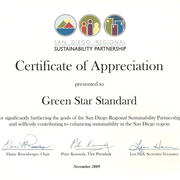Glossary 1

Bio-based Materials
Bio-based (Biomass or Renewable) based materials. Organic material(s) containing in whole or part biogenic carbon (carbon from biological sources) Organic Material(s) containing carbon based compound(s) in which the carbon is attached to other carbon atom(s), hydrogen, oxygen, or other elements in a chain, ring, or three dimensional structures (IUPAC nomenclature; ASTM D6866 is a Standard Test Methods for Determining the Bio-based Content of Solid, Liquid, and Gaseous Samples Using Radiocarbon Analysis.
Bio(carbon) Content
The bio-content in plastic is based on the amount of biogenic carbon present, and defined as the amount of bio carbon in the plastic as fraction weight (mass) or percent weight (mass) of the total organic carbon in the plastic. (ASTM D6866) % bio or bio-based content = ([Bio (organic) carbon]/[total (organic carbon)] * 100)
Bio-degrade (Aerobic)
Composting environment (the first two are specification standards based on using D5338 test method to measure percent biodegradability). ASTM D6400 ¯ Standard Specification for Compostable Plastics.
ASTM D6868 ¯ Standard Specification for biodegradable plastics used as coatings on paper and other compostable plastics.
ASTM D5338 ¯ Standard test method for determining aerobic biodegradation of plastic materials under controlled composting conditions.
Soil environment ASTM D5988 -- Standard Test Method for Determining Aerobic Biodegradation in Soil of Plastic Materials or Residual Plastic Materials After Composting.
Marine environment ASTM D7081 ¯ Standard Specification for non-floating biodegradable plastics in a marine environment.
ASTM D6691 ¯ Standard Test Method for Determining Aerobic Biodegradation of Plastic Materials in the Marine Environment by a Defined Microbial Consortium or Natural Sea Water.
Biodegrade (anaerobic)
Anaerobic digester environment (biogas energy production) ASTM D5511 ¯ Standard Test Method for Determining Anaerobic Biodegradation of Plastic Materials under High-Solids Anaerobic-Digestion Conditions
Landfill environment ASTM D6776 -- Standard Test Method for Determining Anaerobic Biodegradability of Radio-labeled Plastic Materials in a Laboratory-Scale Simulated Landfill Environment
ASTM D5526 -- Determining Anaerobic Biodegradation of Plastic Materials under Accelerated Landfill Conditions
Chemistry
Chemistry is the science concerned with the composition, behavior, structure, and properties of matter, and the changes it undergoes during chemical reactions (“molecular transformation”).
Green Chemistry
Also called sustainable chemistry, is a chemical philosophy encouraging the design of products and processes that reduce or eliminate the use and generation of hazardous substances.
Green Chemistry Metrics
Green chemistry metrics measures efficiency in a chemical process. Having made a green chemistry improvement to a chemical process, it is important to be able to quantify the change.
Example metrics for green chemistry include effective materials efficiency, atom economy, process mass intensity (PMI), effective mass yield, carbon efficiency, mass yield, reaction mass efficiency, environmental (E) factor, comparison of metrics, and the eco-scale.
Green Chemistry Principles
“Green Chemistry Principles” as published by Anastas, P.T.; Warner, J.C.; Green Chemistry: Theory and Practice, Oxford University Press: New York, 1998, p30.
Green Engineering Principles
“Green Engineering Principles” * Anastas, P.T., and Zimmerman, J.B., "Design through the Twelve Principles of Green Engineering", Env. Sci. Tech. 2003, 37(5), 94A-101A.
In addition, the USEPA web site lists the 9 “Principles of Green Engineering” as developed by more than 65 engineers and scientists at the Green Engineering: Defining the Principles Conference, held in Sandestin, Florida in May of 2003.
Greener Chemical(s) (embodied resources and waste)
The amount of embodied resources (chemicals, water and energy) and waste (solid waste, liquid waste (aqueous and non-aqueous), air pollution waste and green house gas waste) determines how green the chemical product is. The lesser the amount of embodied resources and waste is the greener option for the chemical(s).
Greener Chemical(s) (inherent chemical characteristics)
Greener chemicals are defined by the inherent hazard and renewability characteristics. As the inherent hazard characteristics (human health, physical safety, ecological impacts) are lessened, the greenness of the chemical(s) increase.
The Inherent hazard chemical characteristic categories are as follows:
- Human Health (acute and chronic health characteristics)
- Physical Safety (corrosive, flammable, explosive)
- Ecological Impact (persistence, bio-accumulation, toxicity, long term impact, other)
As the renewability characteristics increase, the greenness of the chemical(s) increase.
The inherent “renewability” characteristic categories are as follows:
Bio-based chemical(s)
Ability for a chemical(s) to be degraded into bio-mass (This only applies if it is degraded into biomass).
Green House Gases (GHG)
The primary 6 green house gases of concern are carbon dioxide, methane, nitrous oxide, hydro-fluorocarbons, per-fluorocarbons, and sulfur hexafluoride. The main sources of these gases due to human activity are as follows: Carbon Dioxide (CO2): burning of fossil fuels and deforestation;
Methane (CH4): livestock enteric fermentation (i.e. cows) and manure management, paddy rice farming, land use and wetland changes, pipeline losses, and covered vented landfill emissions;
Hydro-fluorocarbons (HFC): these items are of concern from the standpoint of global warming and the Kyoto Protocol;
Per-fluorocarbons (PFC): these are being used in refrigerating units as replacements for CFCs;
Nitrous Oxide (N2O): this is used for its anesthetic and analgesic effects as well as being used as an oxidizer in rocketry and in motor racing to increase the power output of engines;
Sulfur Hexafluoride (SF6): used in the electrical industry as a gaseous dielectric medium for high-voltage (35 kV and above) circuit breakers, switchgear, and other electrical equipment, often referred to as SF6. SF6 is also employed as a contrast agent for ultrasound imaging.
Greener Process
Greener Process is a process philosophy encouraging the design of processes and products that optimize resource use, utilize greener resources, and that reduce or eliminate the use and generation of hazardous substances.
Greener Resource (extraction)
The removed extracted resources (chemicals, water and energy) do not negatively impact people or the ecology (e.g. depleting resource, habitat destruction, other).
Greener Resource (in-use)
Resources (chemicals, water and energy) that when used for their intended purpose do not negatively impact people or the ecology. For example, greener energy is renewable and or low carbon dioxide and equivalent emissions.
Greener Waste (environmental regulations)
Waste (solid waste, liquid waste, air pollution waste and green house gas waste) is defined by the applicable environmental regulations. The lesser hazard class is the greener waste.
Waste that is recovered as a resource, recycled or is degradable may be classified as a non-waste or pollutant per the applicable environmental regulations.
Greener Waste (solid and liquid waste hazard class)
The chemical composition of the waste is required (list of chemicals for the solid waste, liquid waste, air pollution waste and or green house gas waste). Greener chemicals are defined by the inherent hazard and renewability characteristics (see Greener Chemical(s) (inherent chemical characteristics). As the inherent hazard characteristics (health, safety, ecological impacts) are lessened, the greenness of the chemical(s) increase. As the renewability characteristics increase, the greenness of the chemical(s) increase.
Mean Time to Failure
MTTF - Mean In-Use time of use until product or service failes for the first time.
Recycled Content Material
Materials with made from some amount of recycled materials typically listed in percentage.
Recycle
Pre and post materials recovered from an existing product to use in another intended application. Typical materials that are recycled for market value are as follows:
- Cellulose (paper and wood products)
- Metals
- Ceramic
- Plastic
- Oil
- Solvents
- Rubber
- Etc.
Resource Recovery
Materials recovered to use in the same or similar process pre and post product.
Waste Prevention (greener process)
Waste prevention may be defined by the categories given in priority order (1) source reduction and (2) waste reduction. Source reduction is any practice that reduces or eliminates waste by process design. Waste reduction is any practice to reduce the waste after generation (pre and post chemical product). This includes in priority order the (a) reuse of waste (resource recovery) and the (b) recycle or degradation of the waste. The last option is the treatment of the waste for disposal per the environmental regulations.
Waste, Solid (hazardous waste)
Solid waste may be both non-hazardous, hazardous, extremely hazardous and special waste (e.g. radioactive). Hazardous solid waste is defined by the federal, state and local environmental regulations. The federal regulation that defines solid waste as a hazard is the Resource Conservation and Recovery Act (RCRA).
Waste, Liquid (wastewater)
Liquid waste may be both aqueous and non-aqueous; and non-hazardous and hazardous. Aqueous and non-aqueous (e.g. organic compounds such as oil or solvents) liquid waste is defined by the federal, state and local environmental regulations. The federal environmental regulation that defines liquid waste as a hazard is the Resource Conservation and Recovery Act (RCRA).
Waste, Gas (air pollution)
Air pollution is defined by the federal, state and local environmental regulations. The federal regulation that defines air pollution is the Clean Air Act 1990 and the amendments. Air pollution now includes green house gases and is classified as a criteria air pollutant (e.g. the seven basic air pollutants that are generated from fossil combustion sources found in higher concentration in metropolitan areas). Air pollution also includes a list of Hazardous Air Pollutants (HAP).
Waste, Green House Gas
The primary 6 green house gases of concern are carbon dioxide, methane, nitrous oxide, hydro-fluorocarbons, per-fluorocarbons, and sulfur hexafluoride.
Register now for our membership site.





